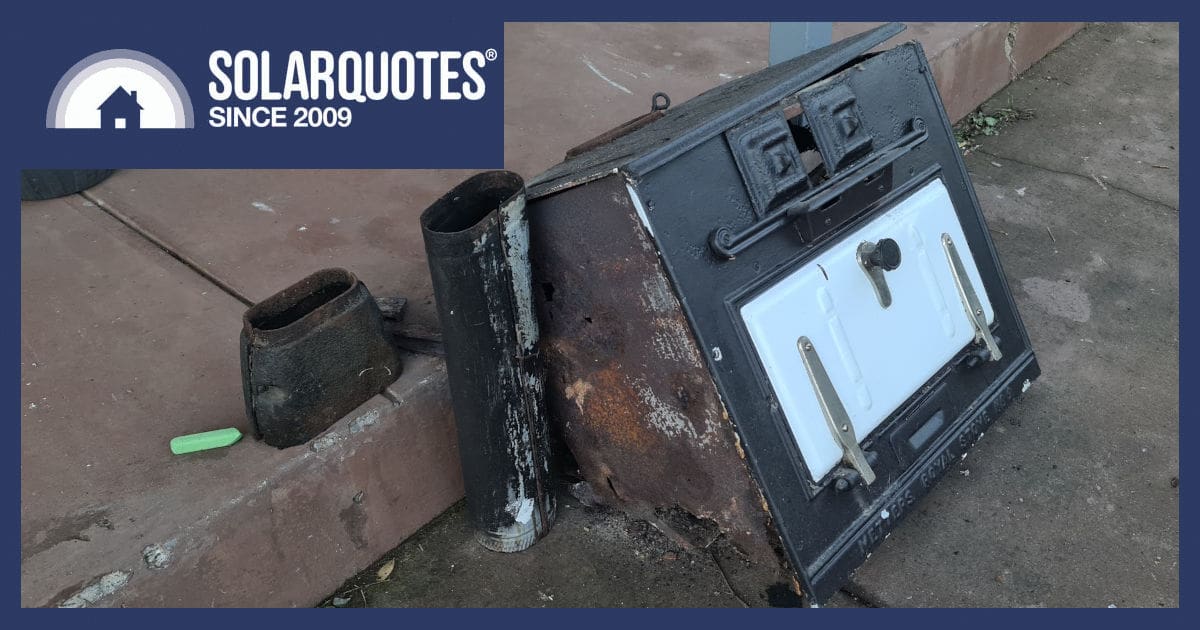
If, like me, you own a character home, it’ll have some unused and outdated features which need dragging into this century.
In this article, we’ll be looking at ways to deal with chimneys, because with the cost of energy these days, nobody needs a gaping hole in their house.
We’ve already detailed how to seal up windows and doors to keep your heat from escaping into the winter wilderness, but this time I’d like to focus on fireplaces.
There’s an architectural maxim that says happiness is directly proportional to ceiling height, and in the days before air conditioning, I know that held true. Keeping cool meant simply keeping the doors shut and letting heat rise, but keeping warm was easy, you just had to burn things in the fireplace.
These days we are aware that particulate pollution is a terrible problem for human health, and the cost of buying wood is substantial these days, with reverse cycle air cons much more cost-efficient at keeping homes warm, especially for people with rooftop solar.
From an energy perspective an open chimney is arguably worse than an open window because it’s a stack designed to suck hot air, quietly and efficiently, out of your house.
Really the only decent argument I’ve heard for an open fire is a romantic one, ie the sex is better.
Chimney Blockers Are A Good Start
Let’s face it, there may be a few times you really need the radiant warmth and atmosphere of an open fire. Humans have been watching “Bush TV” for millennia so rest assured, there are temporary solutions which fill this niche.
At my place energy auditors not only gave us a free shower head and some LED light globes, they supplied and fitted temporary chimney blockers to seal your fireplace whenever it isn’t in use. As a non-standard item for the REPS scheme where I live in SA, you must tell them on the phone you need these, or they’ll have to make a second appointment.
Made from felt, they simply jam inside the chimney, leaving a handle or two hanging down for you to grab. Much like a door snake, they’re not perfect but a massive improvement nonetheless.
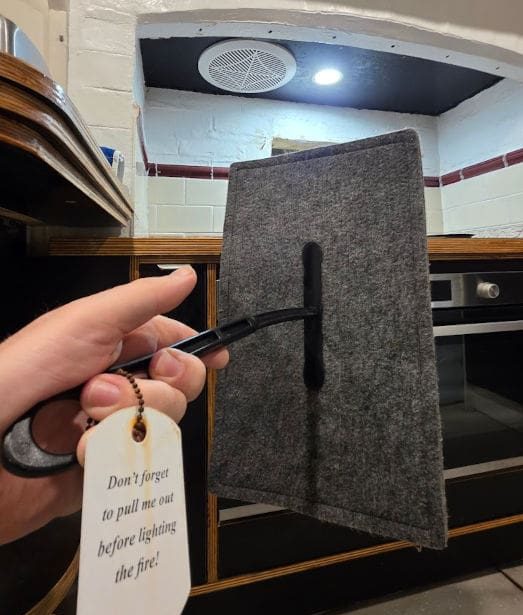
The handle is a bit flimsy but we used this to plug up the chimney before the formboard, fan and light went in.
From Fireplace to Bookcase
If you are looking for a permanent solution, turn the fireplace into something new.
The top of your chimney will dictate whether you can put a terracotta plant pot, folded metal flashing or some other cover to stop the rain and wildlife coming in. Demolishing the chimney so it’s below roof level is also an option that’ll allow you to install more solar.
Inside there are a few options, but my solution is a simple box to form a bookcase with a salvaged drawer underneath.
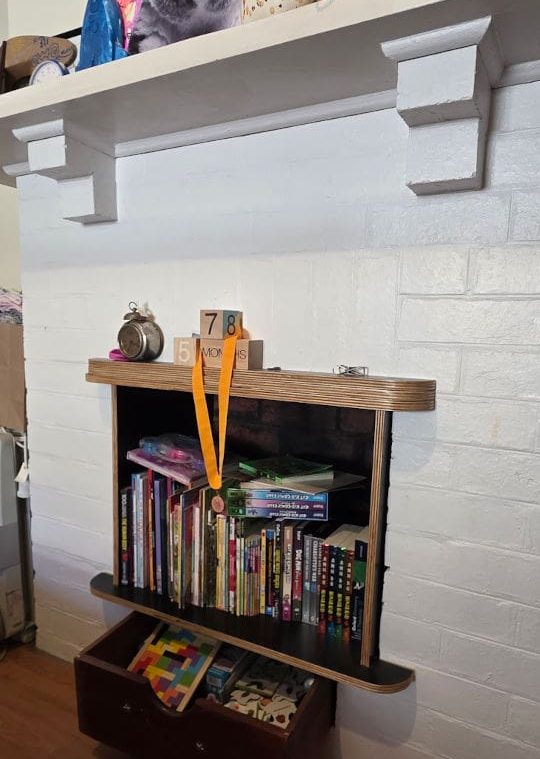
Laying two extra pieces of formply on the top creates a solid shelf and covers the slightly arched opening.
Given a little more budget, I would probably install a floor console air conditioner which is designed to fit flush into existing fireplaces.
Not only do they pump heat out right at floor level, the filters are easily accessible for cleaning. Just be sure to keep little fingers and their toys out of the fragile louvres which direct airflow.
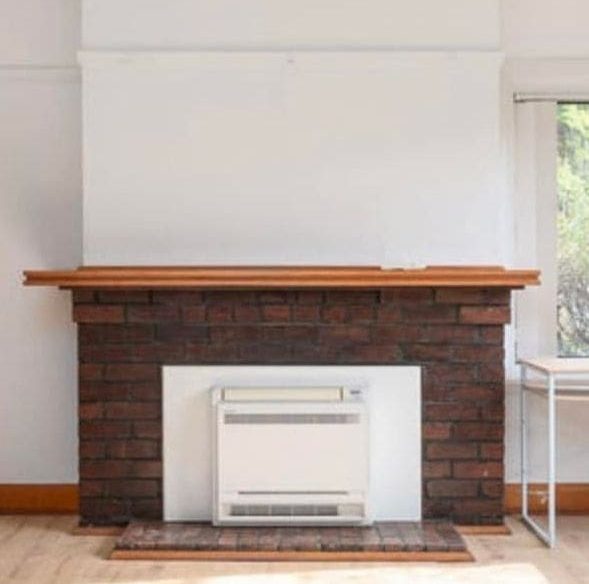
These units often replace an oil or gas fired unit with heating and cooling capacity. Image credit: My Efficient Electric Home
Repurpose Your Kitchen Chimney
With kitchens, there’s potential for an even better fix: induction stoves are fantastic to cook on, easy to clean and cleaner to use.
I struggle to get my head around just how fast you can turn an induction stove down when it’s boiling over, the control is brilliant. By inducing heat straight into an iron based pan, induction is faster and more efficient.
The realtor’s advert for my place featured a genuine wood-fired stove which sadly thankfully was too rusty to contemplate using. While I have seen fridges poked into fireplaces before, we decided to reclaim some bench space and reuse the chimney as a range hood.
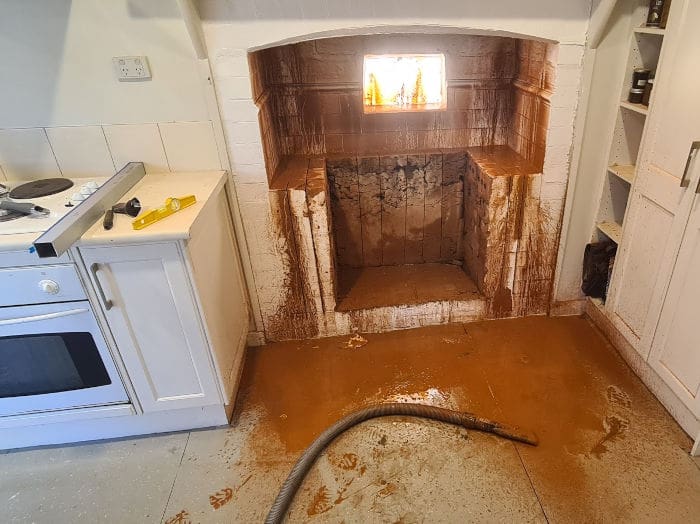
Using a wet brick saw inside the house was going to be messy? Who knew?? At least we could fit a dishwasher when the existing oven came out of the cupboard.
This meant demolishing the brick surround from a couple different generations of stove and finding a horseshoe and a brass bevel gauge built into the hearth. Then I spent a couple of weekends fashioning some formply into a new custom cabinet and (re)routing some wiring for both the stove and oven, plus light and exhaust fan.
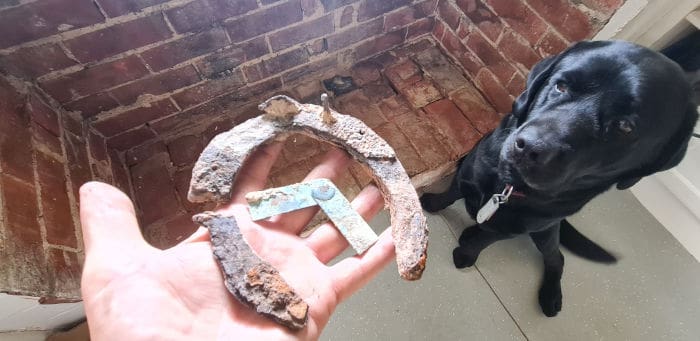
I’ve heard a horseshoe in the hearth may have mystic significance but I suspect someone just dropped their bevel gauge?
Cooking Without Gas
They’re available new, but I’m not lunatic enough to reinstall a wood stove. It would only be romantic until it caused a divorce.
In 2025 we can look back on the wood and coke-fired stoves my grandmothers both used as primitive. Yet in the mid-1950s, they would have found gas a great improvement; it is easier and cleaner than any solid fuel, so I want to underline a point here:
Gas is clean-ish compared to coal, but compared to induction, gas is filthy.
Even if it was cheaper (it isn’t) progress means we’re leaving the gas industry lies to last century.
In reality a gas stoves are known to fill your kitchen with NOx, Benzine and other carcinogens, but of course the gas industry doesn’t market what they’ve known since the 1970s.
And of course we shouldn’t discount the fact an induction stove won’t set fire to the house or kill you with a gas explosion.
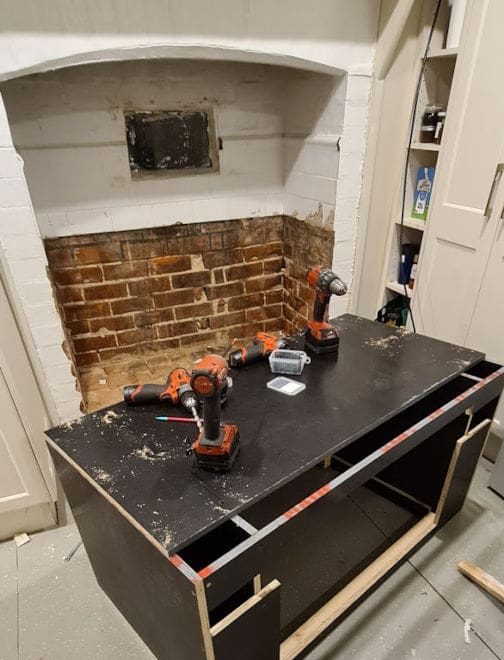
If you cut your sheets just right, there’s plenty of structure and enough gaps for ventilation of the stove top up from the bottom and out through the side drawers.
The biggest worry about installing electric stoves is the question of how much power they need. While our 900mm unit is rated for 11kW at full steam, in reality you never have every burner running so it never needs 47amps at 230 volts.
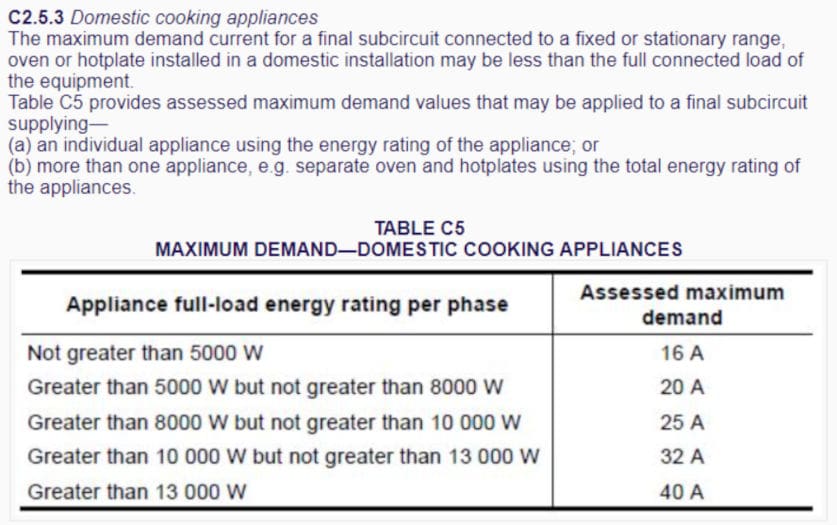
Image credit ECA WA
Consult the good book and you can legally use a 32amp supply. In my case I used the original stove cable to supply the oven, and a new 6mm² cable to feed the stove top.
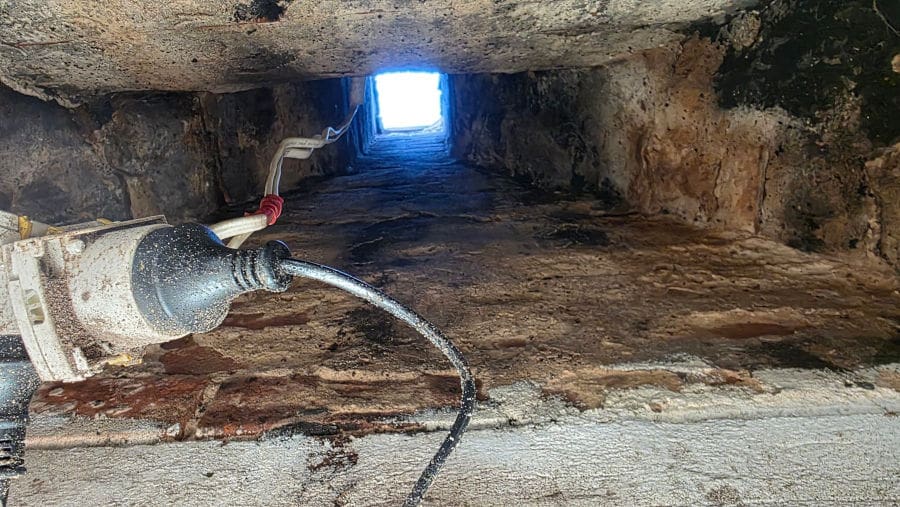
There’s a big hole full of fresh air in this house. Plus we now have wiring drilled through the chimney from inside the roof space to offer a plug base each for lights and fans.
ExtrAction Stations
Fitting a manufactured domestic range hood with fan, filter and light may be possible but I know from experience you can sometimes struggle for space inside the chimney.
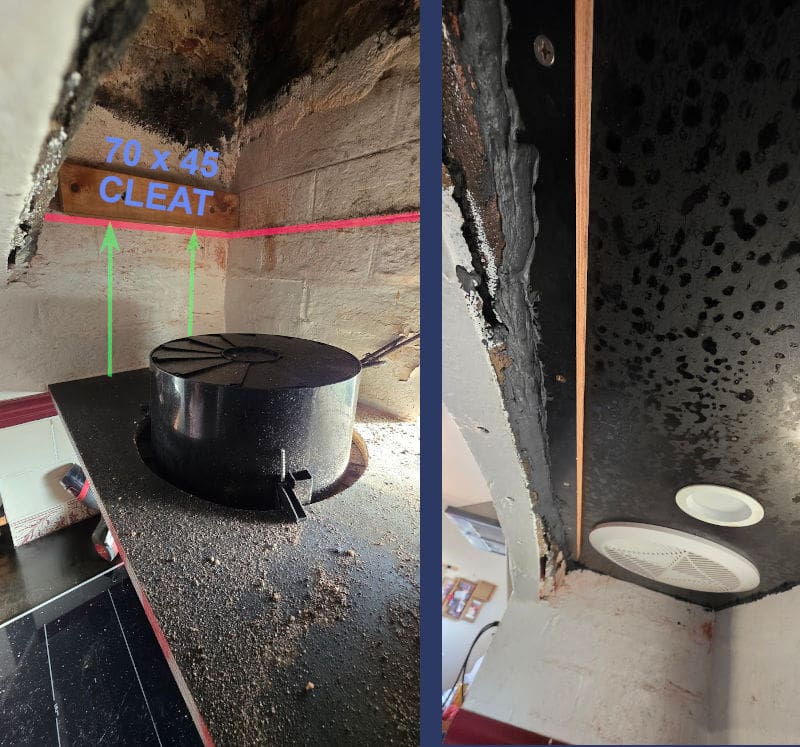
Timber screwed inside the chimney takes wood screws (green arrows) to fix this board in place, as indicated by the red line. Note the flaps on the back of the fan to stop backdraft. On the right I’ve added a profile cut stip to fill the uneven gap, then struggled with upside down caulking.
My first attempt at a range hood used a piece of white melamine faced chipboard. Turns out that’s not stiff enough so replacing it with phenolic faced formply prevents sags.
The second try used the same cheap exhaust fan and a genuine Australian made DraftStoppa to prevent backflow. Due to a clash between these two, the fan mounting lugs would foul the fan blade when it wasn’t turned on, and this flaw was a most instructive feature.
When the wind howled outside, air pushed in through various gaps all over the house, which made the fan turn like a windmill, producing an audible clicking noise as our heated atmosphere disappeared up the chimney.

The gap on the left is too big for caulking. Rolling a LEGO tyre along the irregular surface gives you a line to cut to (in red). This cardboard template means you can profile cut a filler piece with a jigsaw, as seen above.
With gaps around the edge it’s remarkable how much air will still be pulled up the chimney without using the fan.
For round three I’ve bought a more powerful fan with integral shutters, and this time we’ll caulk the edges.

Atomic Coffee – so strong it shakes the building
Formply is super strong, comes in consistent sized sheets and is very easy to clean. Seriously, you can use it as a workshop bench and hit it with high aromatic brake solvent to wipe off motor oil, so I’ve rebuilt a whole kitchen with it.
My biggest tip for this arrangement is remember to clean the fan occasionally and if you really want a Rolls Royce job, get a commercial mushroom fan with a shutter, which doubles as a waterproof hood on the outside.
Insulation For Winter Will Also Help Through Summer
That’s a wrap for my series on DIY around the home to keep warm in winter: if you haven’t already take a look at my tips on insulation for windows, doors, and the rest of the house.
As winter withdraws it’s cold feet and we head into who knows what, I hope this series of posts has helped explain the importance of trapping the energy you can harvest from your roof for use after sundown.
These tips will more or less help through summer too, lets hope it’s not too brutal.

 RSS - Posts
RSS - Posts



The most interesting use of an old chimney I’ve seen is to vent the sub-floor space in a home with minimal sub-floor ventilation. Just break through the floor of the old fireplace to the sub-floor, seal up the fireplace itself and hey presto, permanent sub-floor induced draught ventilation. With a mesh or something on top of the chimney to stop birds or other critters ending up in the basement.
I love my solid fuel heater, nothing comes close to the ambience it provides. As I live on several hectares with so many trees that come to their end via bushfire, lightning, high wind. The fuel costs are running my chainsaw, and my calories.
I have an induction Cooktop. Gas BBQ outside on the patio.
Buying firewood has become expensive if you don’t have a supply on your property.
And I agree induction cooktops are the safest of them all. But again the expense of electricity is out of control. And it seems no end in sight to become cheaper.
So I have solar and batteries to protect my grid outages and eventually my hip pocket.
Just received a notice from ACTEWAGL my payment per kWh is dropping from 12 cents to 6 cents for the first 15kWh then after 15 kWh it dropping from 6 cents to 3 cents.
And just after the Feds announcement will help by increasing support by $75.
Long ago, I read that an open fireplace sends 90% of the heat up the chimney, and a closed wood heater typically has 400% better fuel utilisation as it can yield 40% in room heating. Before I demolished the fireplace in the old house, we blistered the varnish on the front legs of wooden chairs, while still having cold backs, sitting in them, close to the fire. OK, uninsulated cementsheet and masonite construction doesn’t help much, but fireplaces suck.
The wood heater which followed had a narrower brick chimney, closed at floor level with a small hatch. Whenever a possum took up summer residence, it took me a few deep breaths to reach in to grab the screaming demon, standing on front legs to better present bared fangs to the very low opening. Thick welding gloves and helmet with mesh visor were used – without need to refer to OH&S rules first. They one which got out & hid behind the christmas tree was the trickiest, though, with children & presents all over. Ah, farm life. 🙂
Your arguments to stop using timber and natural gas due to toxins loses some credibility when you claim to use toxic brake cleaner on your work bench. I cook on gas which currently costs around $30 per year and the rangehood is an effective remover of combustion products. Meanwhile the aged dried timber burnt in my efficient box fire costs me nothing. No fumes enter the house. Electricity has it’s advantages when generated at home but it’s not worth throwing the gas cooker out and spending thousands replacing it.
Your brake cleaner: Brake cleaning products contain hydrocarbons like benzene and toluene, a benzene derivative. Benzene is known to cause blood cancer and bone marrow cancer like acute myeloid leukemia (AML), multiple myeloma (MM), myelodysplastic syndrome (MDS), and non-Hodgkin’s lymphoma (NHL). You breathe it in and it’s absorbed through the skin.
I’d rather breathe the odd oxide of nitrogen.
Hi Brian,
I didn’t think I’d need to clarify by I don’t wipe motor oil off the kitchen bench every night, nor do I use nitrile gloves while cooking tea.
These are things you do in a well ventilated workshop.
You’re right about the ventilation part but I’d encourage you to read this link:
https://reneweconomy.com.au/gas-industry-knew-about-air-pollution-problems-from-stoves-in-early-1970s/
And make sure you follow the hyperlinks throughout which provide evidence for the assertions in the article.
The gas industry has been lying to us about the safety of gas for decades.
All electric homes are cleaner, easier to live with and safer.
Electricity is also cheaper.
The gas industry knows this and so they’re ramping up with greenwashing, half truths and food based marketing to try and arrest the decline.
Brian: – “I cook on gas which currently costs around $30 per year and the rangehood is an effective remover of combustion products.”
How do you know the rangehood “is an effective remover of combustion products”? Have you done air sampling with scientific instruments?
Modern extraction fans over gas stoves don’t eliminate health risks completely.
https://www.abc.net.au/news/2021-05-23/can-gas-stovetops-give-you-asthma/100157786
And what makes you think gas supplies will remain abundant/affordable? US petroleum geologist Art Berman suggests a supply shock is coming:
“…I’m quite confident that before this decade is over we’re going to see some serious supply concerns by markets for both oil and natural gas, and it would not surprise me if that happened in a year or two, ah, as opposed to, you know, the five or six years that we have remaining in this decade.”
https://youtu.be/rv85LTMO8TQ?t=2233
We’ll see soon if Berman is in the ball park
One thing that people tend to ignore (or, alot of the public are not aware of), is that, when burning solid fuel, whether it be in wood heaters in houses, or, the government arsonists burning the vegetation of Australia, or, backyard fires (and barbeques), is that one of the products of burning solid fuel, other than in a specially designed, extremely high temperature incinerator, is dioxin. It is the chemical in Agent Orange, and, all of the above fires (except in the especially designed, extremely high (higher than bushfires) temperature incinerators, is like spraying everyone and everything around you, with Agent Orange. Most people nowadays, are too young, to remember Agent Orange, like they are too young to remember mustard gas and Hiroshima and Nagasaki.
Put simply, the burning of solid fuels, in other than an extremely high temperature, especially designed incinerator, is, amongst other things, the use of chemical weapons, against all animal life forms where the fumes travel.
Part 2: This quote coincides with my current dioxin understanding:
“What chemicals are released when burning wood?
The toxic chemicals released during burning include nitrogen oxides, sulfur dioxide, volatile organic chemicals (VOCs), and polycyclic organic matter (POMs).
Burning plastic and treated wood also releases heavy metals and toxic chemicals such as dioxin.”
That has been the science for the last 40 years, that I’ve read. (The dioxin comes entirely from added chlorine containing plastic/chemicals.) If there is new data, I’m curious.
To avoid VOCs, I’ll have to ditch my spectacle wipes and many household products. But as I don’t hold my head over the chimney, those from the wood fire are much safer.
A more real issue, I think, is that there’s PFAS in rainwater, so nowhere is safe from that now. Reverse osmosis is said to be better than activated carbon and ionic exchange filters.
”
Dioxins are mainly by-products of industrial processes but can also result from natural processes, such as volcanic eruptions and forest fires. They are unwanted by-products of many manufacturing processes including smelting, chlorine bleaching of paper pulp and the manufacture of some herbicides and pesticides. Uncontrolled waste incinerators (solid waste and hospital waste) are often the worst culprits of environmental release due to incomplete burning. Technology is available that allows for controlled waste incineration with low dioxin emissions.
”
-https://www.who.int/news-room/fact-sheets/detail/dioxins-and-their-effects-on-human-health
But, if you decide to deny what the World Health Organisation scientists say, then I cannot do much about that.
Denying what the World health Organisation scientists say, is a bit like the Trumpet stuff, with the objective of causing the most possible harm, with loud noise
i would rather breathe safe, clean air, than be deliberately poisoned.
Bret, replying here for the record, rather than encouraging polemics, I encourage you to actually read the WHO item you linked to.
It does not ascribe dioxins to “solid fuels”, instead 90% to foods, the rest predominantly to industrial processes, particularly waste incineration, where plastic will be the dioxin source. Volcanoes get a mention, as do forest fires, but there is *no text match* on “solid fuel” or “wood” anywhere on the page.
Here, bushfires usually end up burning numbers of houses and haysheds. Burning furniture and plastic-wrapped silage bales will doubtless generate some dioxins. Even the plastic twine, too. Burning PVC downpipes and guttering, however, *is* a dioxin bomb.
Dunno if a reread of your own link might help clear your thoughts, correcting spurious conflations, but I do thank you for making my case, and disproving the initial scaremongering. (Read it over a cup of coffee, perhaps?)
From the World Health Authority: “More than 90% of human exposure is through food, mainly meat and dairy products, fish and shellfish.”
I’m not sure if you covered them in your other article but closing off our wall vents made a huge difference.
We used to go through 200 Ltrs of Heating oil in Winter and that was on the lowest heat setting, with much of that heat escaping through the wall vents.
I miss the tiny glass window in the oil fire but that is about it.
Brett, as dioxins are produced in herbicide manufacture, paper bleaching, and are emitted in internal combustion engine exhaust, I’m having trouble understanding the association with “solid fuels”. The number of different dioxin chemicals is significant, but they all seem to be chlorinated hydrocarbons. So I can see how they’re produced in quantity by folk putting PVC in their incinerators.
But what is the chlorine source in wood, wheat stubble, or grass? DEH’s assumption that “150 – 2,100 g” is “thought to be” annually emitted by wildfires, seems entirely spurious. There are so many opinions these days, devoid of supporting data, purporting to be authoritative, all glossy report and fancy letterhead … but zero science.
Peanut butter has more dioxins than eggs or bacon, and breast milk is iffy, but reactive chlorine in trees? Maybe I’ll give up on the peanut butter, for safety.
Yes, Erik… so many opinions out there.
If you look up the dictionary definition of opinion you find: “A belief or conclusion held with confidence but not substantiated by positive knowledge or proof”.
That’s why I tend to ignore them.
We have Gourmet Cooker Fire which does 4 things for us. During winter we use it to cook on instead of the gas stove. It also has an oven which we use all the time. It heats our SHWS during winter instead of using the electric booster and it heats our whole home. For the past 25 years I think I have purchase 2 trailer loads of wood for about $200 in total the rest I have collect locally from the verge on green pick up days. There is so much good wood going to waste out there.
Hi Shane,
Collecting wood from the roadside is illegal last I checked.
In many instances, roadsides are the very last vestiges of natual flora we have, so ripping firewood out of the verge along with the fungi, insects & animals they harbour is really just vandalism.
When we cut trees off the fencelines at the farm some of it goes home into the wood shed, but what’s outside the fence goes back there.
Its wood already cut and placed on the verge by home owners ready for green waste collection service.
Cheers for the clarification Shane
You can also get wood from tree fellers as I understand it.
A big one i see for where i live and work (Part of Australia) is the old whirlybird! I see so many on houses spinning away every winter. I explain to my customers with them about the warmth they are removing from the ceiling space during the colder days. I know there are ways to cover them (the old plastic shopping bag, although maybe not so much anymore) I’ve also seen covers made up for them. The only down fall I see is the need to get up on the roof to put things over them. I get that most of you guys that write these articles live in certain states and regions of Australia. But there are other Regions and States as well that people (Solar Owners) live in and follow your articles. Hopefully someone who lives in the more Northern parts of Australia sees my comment and can understand.
Thanks
Hi Scott,
I’ve always had a fascination with these units but sadly they’re not available any longer.
https://www.airgroup.com.au/pdf/solectair.pdf
A couple of items you missed Anthony which other may benefit from:
1)
Evap cooling vents – where we are in SA, many homes have evaporative cooling with ceiling vent/s used to bring the cool moist air in during summer. However, during winter, these vent/s act as a chimney, venting the warm air/heat up and out of the building envelope even with the louvres closed shut. They are not airtight. Solution? Seal these vents up each autumn with a solid sealed panel screwed into the vent frame. Remove in spring.
2)
Your rangehood is a chimney! Kitchen rangehood with outside venting – we have installed a matt-black rangehood with an external motor on the roof via a conduit. There is no non-return airflap installed. So I noticed last winter, cold air dropping down into the kitchen, presumably being exchanged for our expensive warm air venting out! Solution? Black Coreflute cut to shape and attached using velcro dots when not in use. Cheap and works a treat. Unobtrusive too. No one notices it.
Good points Pete.
Thanks
We were concerned about air quality with our slow combustion stove, which also boosts our HWS. The meter on our air purifier revealed the main problem was from our electric stove top, that sits in the old kitchen stove chimney.
Anthony, if you have a 4th go, I recommend the Shweigen Silent Rangehood. The fan sits on top of the chimney, complete with backdraft prevention, connected to the rangehood by flexible ducting down the chimney. It’s not silent, but it’s quieter than an exhaust fan or a standard rangehood.
I love my slow combustion stove, but I can’t kid myself that it’s not bad for the environment. While I don’t have close neighbours to poison, it does produce greenhouse gases. https://www.theguardian.com/australia-news/2025/aug/09/a-burning-issue-why-its-time-to-ditch-the-wood-fired-heater-and-opt-for-eco-alternative
I’m sitting here pre-heating my house with free solar electricity, likewise my hot water. The slow combustion stove is a guilty pleasure used sparingly now.
I have a Schweigen too.
I have an open plan “big room” Kitchen/Dining/Lounge/Office set up. I finish off the Cooking and Nibblies preparation in front of Guests. When they comment on how quiet it is, I wind it up to 5 and between drinking, canapes and my cooking, we don’t have raise out voices to talk.
For the next Q, how do you heat the place?
With a Coonara Woodfire. I live in a small New England town. All Walls are ICF (Google it) with the HD polystyrene having an R2.4 rating, with a sealed 125mm Concrete thermal mass, honeycombed throughout the ICFs. And I have it clad with Cypress Pine planks with a 20mm thermal gap between the cladding and the walls. All glazing is double glazed, except the Oven window and that’s triple glazed.
Our renovation dismantled the chimney to use the bricks as outdoor paving material, and installed a wood fired Esse Bakeheart stove/oven/space heater which importantly includes an underfloor air inlet to the firebox. So air within the building is not consumed by the fire. We also installed an HVR system to assist distribution of warm air around the house. The renovation provided many winters of 100 year old hardwood for fuel. We find it an excellent solution for central Victorian property. Solar panels provide power for other appliances.